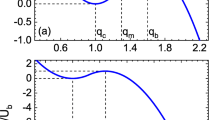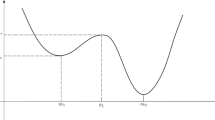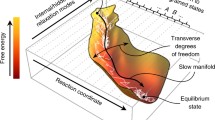Abstract
The time evolution of the thermally activated decay rates is considered. This evolution is of particular importance for the recent nanoscale experiments discussed in the literature, where the potential barrier is relatively low (or the temperature is relatively high). The single-molecule pulling is one example of such experiments. The decay process is modeled in the present work through computer solving the stochastic (Langevin) equations. Altogether about a hundred of high precision rates have been obtained and analyzed. The rates are registered at the absorption point located far beyond the barrier to exclude the influence of the backscattering on the value of the quasistationary decay rate. The transient time, i.e., the time lapse during which the rate attains half of its quasistationary value, has been extracted. The dependence of the transient times upon a damping parameter is compared with that of the inverse quasistationary decay rate. Two analytical formulae approximating the time-dependences of the numerical rates are proposed and analyzed.







Similar content being viewed by others
References
G D Adeev, A V Karpov, P N Nadtochii and D V Vanin Phys. Elemen. Part. At. Nucl. 36 378 (2005)
Y Abe, S Ayik, P-G Reinhard and E Suraud Phys. Rep. 275 49 (1996)
E Vardaci et al Phys. Rev. C 92 034610 (2015)
G Hummer and A Szabo Biophys. J. 85 5 (2003)
O K Dudko, G Hummer and A Szabo Phys. Rev. Lett. 96 108101 (2006)
S Santucci, L Vanel and S Ciliberto Eur. Phys. J. Spec. Top. 146 341 (2007)
H A Kramers Physica 7 284 (1940)
S Zambelli Arch. History Exact Sci. 64 395 (2010)
P Talkner and P Hänggi New Trends in Kramers’ Reaction Rate Theory. (Berlin: Springer) p 251 (2012)
M K Chaudhury and P S Goohpattader Eur. Phys. J. E 35 131 (2012)
I I Gontchar et al Phys. Rev. C 82 064606 (2010)
I I Gontchar and M V Chushnyakova Pramana J. Phys. 88 90 (2017)
M V Chushnyakova, I I Gontchar and A I Blesman J. Phys. Conf. Ser. 1260 092001 (2019)
I I Gontchar, M V Chushnyakova and A I Blesman J. Phys. Conf. Ser. 1260 092002 (2019)
M V Chushnyakova and I I Gontchar Phys. Rev. E 97 032107 (2018)
M V Chushnyakova and I I Gontchar Braz. J. Phys. 49 587 (2019)
P Hänggi, P Talkner and M Borkovec Rev. Mod. Phys. 62 251 (1990)
H-X Zhou Q. Rev. Biophys. 43 219 (2010)
P Grangé, L Jun-Qing and H A Weidenmüller Phys. Rev. C 27 2063 (1983)
I I Gontchar and N E Aktaev Phys. Rev. C 80 044601 (2009)
M V Chushnyakova, I I Gontchar and A I Blesman J. Phys. Conf. Ser. 1050 012018 (2018)
I I Gontchar, M V Chushnyakova and A I Blesman J. Phys. Conf. Ser. 1210 012052 (2019)
A E Gettinger and I I Gontchar J. Phys. G 26 347 (2000)
I I Gontchar Phys. Elemen. Part. At. Nucl. 26 394 (1995)
I Gontchar, L A Litnevsky and P Fröbrich Comput. Phys. Commun. 107 223 (1997)
W Ye Phys. Rev. C 79 031601 (2009)
W Ye, N Wang and X Chang Phys. Rev. C 88 054606 (2013)
I I Gontchar and M V Chushnyakova Chin. J. Phys. 67 388 (2020)
M V Chushnyakova and I I Gontchar J. Phys. G 40 095108 (2013)
M V Chushnyakova, R Bhattacharya and I I Gontchar Phys. Rev. C 90 017603 (2014)
Y Wang et al Chin. J. Phys. 56 1187 (2018)
N E Aktaev, A A Fedorets, E Y Bormashenko and M Nosonovsky J. Phys. Chem. Lett. 9 3834 (2018)
H A Oliveira and G J Delben Chin. J. Phys. 60 141 (2019)
J Xu and X Luo Chin. J. Phys. 63 382 (2020)
H Risken and T Frank The Fokker–Planck Equation, 2nd ed. (Heidelberg: Springer) p 472 (1996)
P E Kloeden and E Platen Numerical Solution of Stochastic Differential Equations. (Heidelberg: Springer) p 636 (1992)
M Büttiker, E P Harris and R Landauer Phys. Rev. B 28 1268 (1983)
E Pollak, H Grabert and P Hänggi J. Chem. Phys. 91 4073 (1989)
Author information
Authors and Affiliations
Corresponding author
Additional information
Publisher's Note
Springer Nature remains neutral with regard to jurisdictional claims in published maps and institutional affiliations.
Appendix
Appendix
The time step \(\tau\) of the numerical modeling is a technical parameter which, being chosen correctly, should not influence the physical results. To demonstrate the accuracy of our numerical calculations, we show in Table
1 how the calculated quasistationary decay rate \(R_{{\text{D}}}\) depends upon \(\tau\) for several values of the damping and governing parameters. While the time step is relatively large and decreases, the same happens to \(R_{{\text{D}}}\): this means that \(\tau\) is too big.
At the smaller values of the time step, the decay rate ceases to depend regularly upon \(\tau\) as it is expected. Finally, when the time step becomes small enough the quasistationary decay rate \(R_{{\text{D}}}\) stays constant within the statistical errors. One sees this behavior of \(R_{{\text{D}}} \left( \tau \right)\) for any set of the damping and governing parameters in Table 1.
Rights and permissions
About this article
Cite this article
Chushnyakova, M.V., Gontchar, I.I. & Khmyrova, N.A. Activated decay of a metastable state: transient times for small and large dissipation. Indian J Phys 96, 1599–1605 (2022). https://doi.org/10.1007/s12648-021-02061-w
Received:
Accepted:
Published:
Issue Date:
DOI: https://doi.org/10.1007/s12648-021-02061-w




